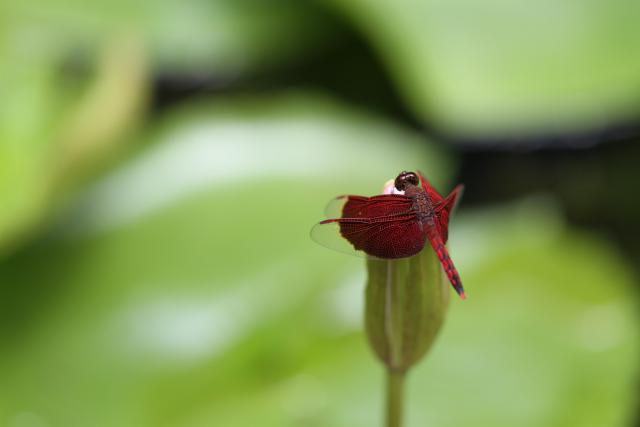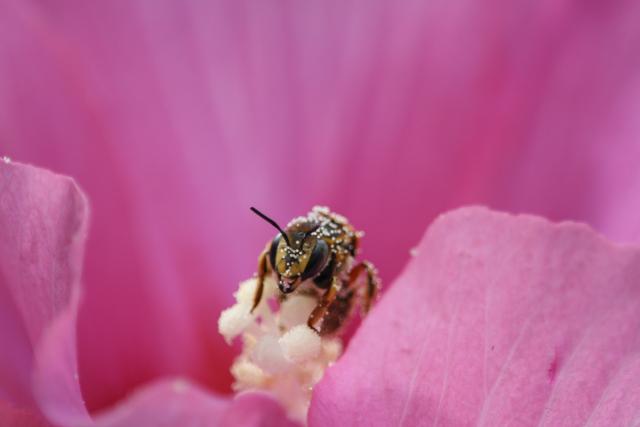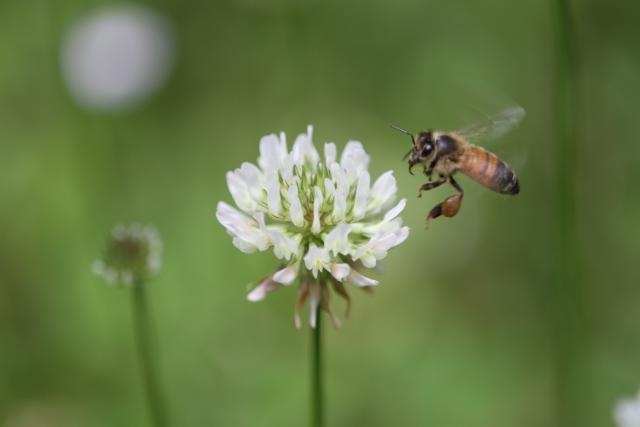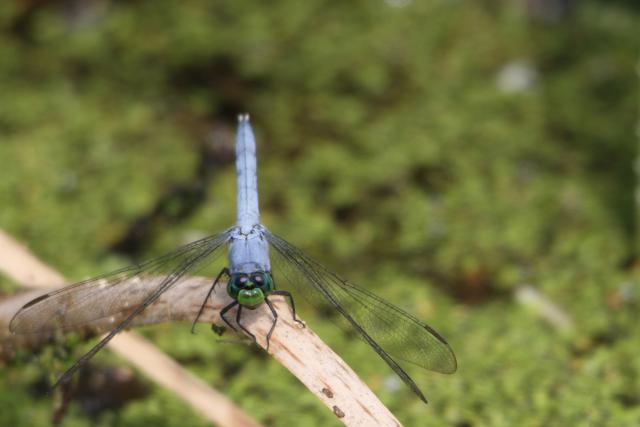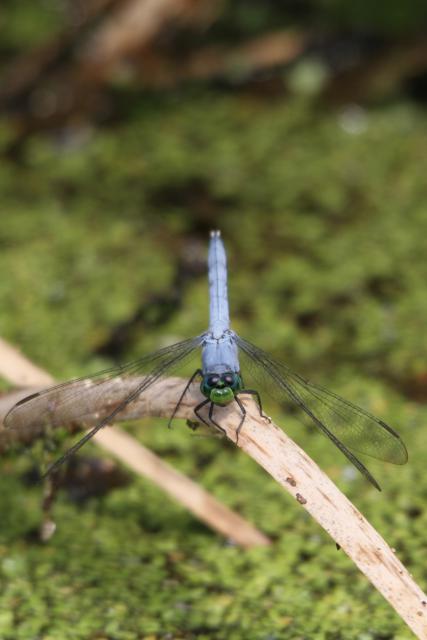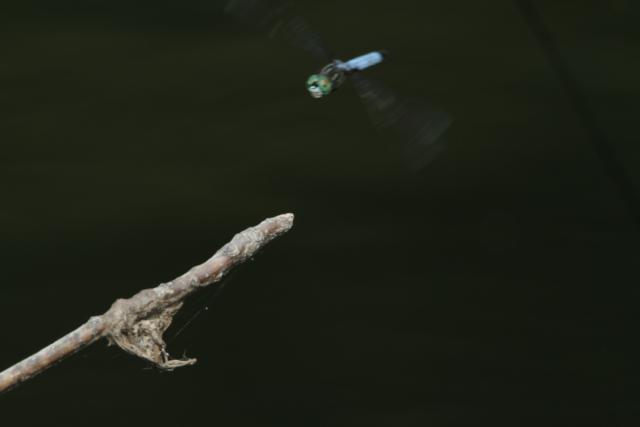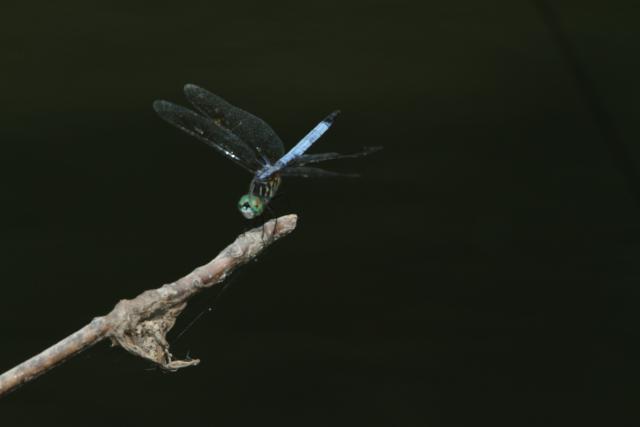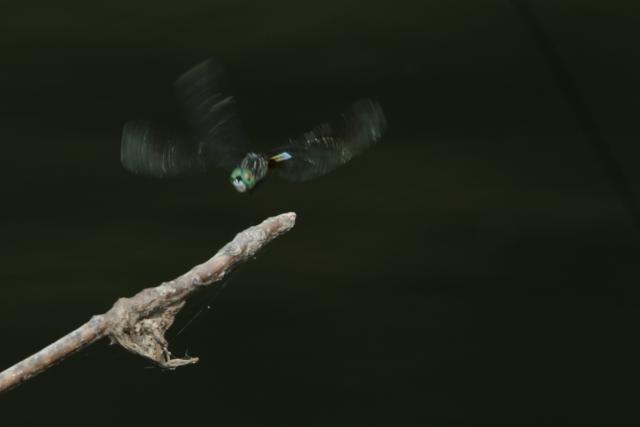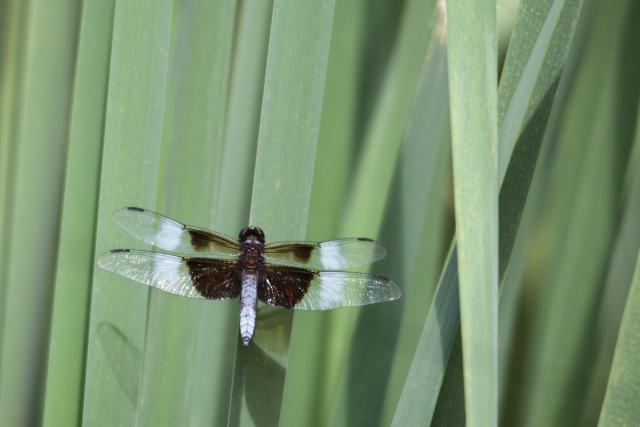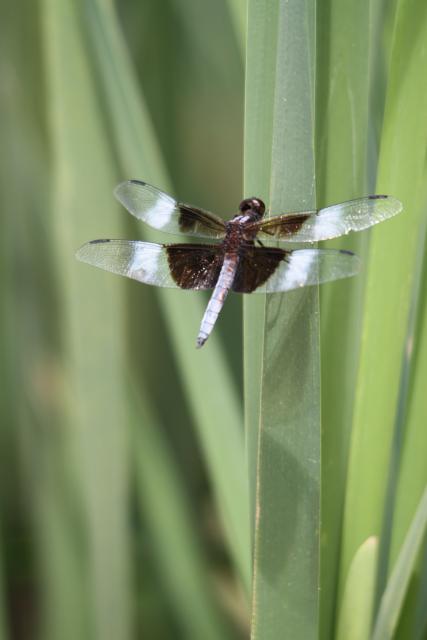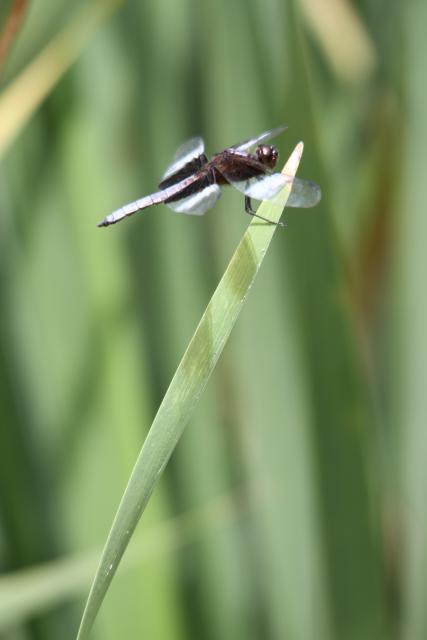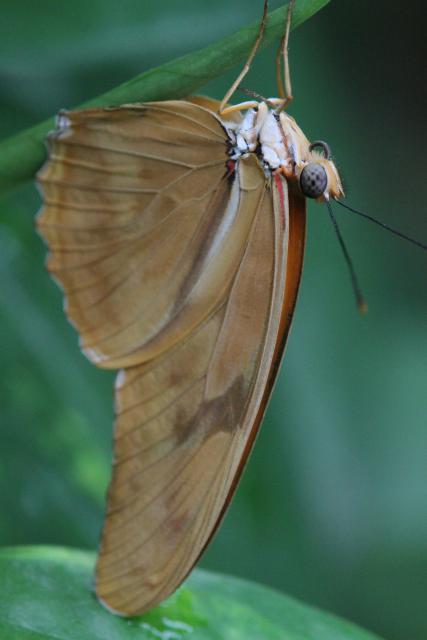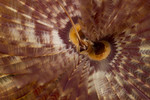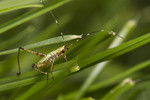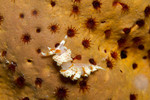insects
Feeding Orange Butterfly
ktuli — Wed, 04/20/2011 - 20:33
I have to admit that this photo is a bit old and actually dates back to when I had no clue what I was doing and was shooting in one of the auto-modes. However, I feel we need something with a little color since the last few have been somewhat drab. With spring finally setting up shop, shots like this will hopefully be more frequently.
Technical Data: Canon EOS Digital Rebel XT, Tamron 180mm f/3.5 Di SP LD 1:1 Macro, 1/320 sec at f/4.5. ISO 400. No post production. Franklin Park Conservatory, Columbus, OH.
Why This Photo: What can I say? I like macro photography, and butterflies make interesting macro subjects.
What Works: A shallow depth of field produces a nicely blurred background, while keeping the camera parallel to the wings of the butterfly keeps them in relatively good clarity. Also, the focus is sharp on the eyes of the butterfly, and a diagonal composition nicely balances the orange butterfly with the green plants.
What Doesn't Work: The antenna breaks the top of the frame, and the depth of field is a bit too shallow to keep the tips of the antenna in clarity.
I also have to apologize that I don't know the species of this butterfly, and I'm feeling a little lazy tonight, so I don't have my normal species information.
I'm just looking forward to getting out and capturing more spring macros soon!
- Bill
Bali: Red Dragonfly
ktuli — Tue, 03/15/2011 - 19:44
Technical Data: Canon EOS 7D, Canon EF 100mm f/2.8L Macro IS USM, 1/790th sec at f/2.8. Image Stabilization on. ISO 200 (Auto). No post production.
Why This Photo: These beautiful red dragonflies were flying around the Puri Santrian hotel among the many water gardens on the grounds. As soon as I saw them, I knew I had to try out the new macro lens with them.
What Works: The off-centered dragonfly is in perfect focus (looking at the fullsize version reveals the intricate detail in the delicate wing. The extremely wide aperture of f/2.8 produces an incredibly soft bokeh background that has just enough shape to show the lily-pads that accompany this closed water lily bud.
What Doesn't Work: That same wide aperture that produced the soft background also produced such a narrow depth of field that the entire dragonfly is not in clarity. I feel this is ok to some extent, but wish that the dragonfly's body and head were in more clarity.
- Bill
Bees and Flowers (part 3)
ktuli — Wed, 10/13/2010 - 12:50
Alright - just a last photo of bees and flowers.
Technical Data: Canon EOS Digital Rebel XT, Tamron 180mm f/3.5 Di SP LD 1:1 Macro, 1/160 sec at f/5.6. ISO 400. No post production. Taken in our own backyard.
What Works: Focus is tack sharp - the detail in the bee is spot on, and the water droplets on the upper flower are nice and crisp. Despite being an outdoor shot, the exposure is nicely done with no over or under exposed areas.
What Doesn't Work: The composition isn't exactly super strong, especially with the bee's head being partially hidden within the flower - perhaps a lower angle would have worked better. Also, perhaps isolating a single flower with the bee would have worked a little better.
- Bill
Bees and Flowers (part 2)
ktuli — Thu, 10/07/2010 - 20:47
Alright - here's day two of the bees and flowers.
Technical Data: Canon EOS Digital Rebel XT, Tamron 180mm f/3.5 Di SP LD 1:1 Macro, 1/800 sec at f/3.5. ISO 400. No post production. Taken in our own backyard.
What Works: The focus is tack sharp on the bee's face. The macro lens really does a great job of magnifying the subject - you can even make out single grains of pollen (apologies if that makes your allergies act up). The foreground petals of the flower do a great job of framing the main subject.
What Doesn't Work: I could have used a smaller aperture to get a slightly deeper depth of field and get the entire bee in focus. Perhaps a catch-light in the closer eye would have been a nice finishing touch.
- Bill
Bees and Flowers (part 1)
ktuli — Thu, 10/07/2010 - 10:05
Well, summer has officially been over for a couple weeks now, and the weather is quickly following suit. Which means that sights like these are all but over for a while.
Fall is probably one of my favorite seasons - the cooler weather is more conducive to outdoor activities, hockey season starts back up, and the fall foliage is always a wonderful gift from nature. Since we had such a hot and dry summer, I don't know colorful of a fall we'll get this year, so I figured I'd let summer linger a little longer.
Technical Data: Canon EOS 7D, Tamron 180mm f/3.5 Di SP LD 1:1 Macro, 1/510 sec at f/3.5. ISO 200. Dolica AX620B100 tripod. No post production. Kanawha State Forest, Charleston, WV.
Why This Photo: I frequently try for photos of insects in flight, and after hiking around for about five hours this day, I decided to take a break by sitting in a field of wild flowers and waiting to see what would come to me.
What Works: The shallow depth of field (which is necessary to help get the fast shutter speed to freeze the motion of the honey bee and flowers in the breeze) produces a nicely blurred background. The focus is fairly sharp, though a bit blurred on the bee itself - whether from missed focus or from motion blur. The catch-light in the bee's eye is a nice touch.
What Doesn't Work: The composition is a bit bland with the flower at the dead center of the photo, perhaps a post production vertical crop would convert this to a more functional photo.
I have a handful more flower and bee photos, so I'll get around to sharing them sooner or later.
- Bill
Poll: Cropped Blue Dasher
ktuli — Thu, 09/02/2010 - 19:35
Alright - bear with me for one more dragonfly photo, and then I'll switch it up.
So today, we'll look at several different crops of the same photo. The subject is a Blue Dasher (Pachydiplax longipennis) that I saw while at Raccoon Creek State Park.
Technical Data: Canon EOS 7D, Sigma 150-500mm f/5-6.3 APO DG OS HSM at 500mm, 1/260 sec at f/8. OS mode 1. ISO 200. Dolica AX620B100 tripod mounted. No post production. Raccoon Creek State Park, Beaver County, PA.
I honestly originally thought that I would like the square crop the best - I'd recently read an article in one of my photography magazines about the virtues of a square crop. However, after seeing them all together, I honestly am not sure which crop I like best. I'll have to debate a bit before deciding.
Place your vote and leave a comment to let me know why you feel the way you do.
- Bill
Landing Dragonflies
ktuli — Wed, 09/01/2010 - 19:34
So one of the shots I've been trying to capture for a while is a dragonfly in flight. As you might expect, it isn't exactly the easiest thing to manage.
The most important thing I've learned is to observe the dragonflies for a while - turn the camera off and just watch. Try and identify a pattern; often dragonflies will repeatedly return to a certain landing point or hover in the same spot. You need to identify those places and prepare for your shot from there. Once you identify a place, setup your camera and compose your shot - don't worry about trying to capture anything just yet. Pay attention to your background, make sure that you won't have something distracting that will ruin the shot if you do end up getting one. Now, moving around and setting up your camera and tripod may very well have spooked the dragonfly. So you'll likely have to wait a bit longer for it to calm down and return to its pattern, but more than likely it will, so just be patient (ie: don't go moving the camera and starting over!). Finally, use a remote shutter release and shoot without using the viewfinder, just fire off bursts when the dragonfly nears the spot you are composes on. And of course, you'll need a faster shutter speed, which probably means a wide aperture.
That all said, I still haven't gotten a perfect dragonfly in flight shot yet. There's always something just a little bit off...
Sometimes I'm too early...
Or too late...
And sometimes I get close, but the focus is not perfect and the shutter speed is a little too slow to freeze the motion of the wings...
And sometimes even a bit closer still - focus is better but continues to not be perfect, but the faster shutter froze the motion of the wings a little better...
So I'm stick with it and keep trying. There are a few more things I'll be keeping in mind next time I'm shooting for one of these. First, I'll try manually focusing on a spot and avoid using auto-focus. Also, I'll make sure I just default to the largest aperture right off the bat to speed up the shutter (and maybe go with a higher ISO). And if possible, I'll get the lighting a little better to brighten up the wings - in the last shot, since they're frozen, they almost disappear - having a bit of highlight lighting on them would help to accentuate the wings and avoid capturing a floating dragonfly body. Perhaps a flash unit would help, but so far I am still nervous about using flash.
It is a challenging shot, that's for sure, but then again - I am not stranger to elusive and challenging shots.
- Bill
PS: Here's the technical data for all of the shots above:
Technical Data: Canon EOS 7D, Sigma 150-500mm f/5-6.3 APO DG OS HSM at 500mm, 1/330 sec at f/9.9 (first three shots) and 1/1020 as f/6.4 (last shot). OS mode 1. ISO 200. Dolica AX620B100 tripod mounted. No post production. Raccoon Creek State Park, Beaver County, PA.
Widow Skimmer Dragonfly (part 2)
ktuli — Tue, 08/24/2010 - 20:23
Just sharing a couple more photos of that Widow Skimmer Dragonfly...
Technical Data: Canon EOS 7D, Sigma 150-500mm f/5-6.3 APO DG OS HSM at 500mm, 1/330 sec at f/6.4 plus 1/3 stop exposure compensation (not sure how that got flipped on). OS mode 1. ISO 200. Dolica AX620B100 tripod mounted. No post production. Raccoon Creek State Park, Beaver County, PA.
Technical Data: Canon EOS 7D, Sigma 150-500mm f/5-6.3 APO DG OS HSM at 500mm, 1/200 sec at f/6.4 plus 1/3 stop exposure compensation (not sure how that got flipped on). OS mode 1. ISO 200. Dolica AX620B100 tripod mounted. No post production. Raccoon Creek State Park, Beaver County, PA.
Feel free to critique to your heart's content in the comments.
- Bill
Widow Skimmer Dragonfly (part 1)
ktuli — Mon, 08/23/2010 - 18:54
Before I get into the photos, I wanted to share some news with everyone. Last week, Anya and I bought some kayaks. So far we've taken them out to the Youghiogheny River at Cedar Creek Park and at the lake at Raccoon Creek State Park. Which leads me into the photos...
Several weeks ago, I went fishing with my dad and brothers at Raccoon Creek State Park and I took my camera along to see what I could catch with it. The fishing wasn't so hot, but I came home with a handful of good dragonfly photos.
This particular species of dragonfly is called a Widow Skimmer (Libellula luctuosa). And we saw many more while out kayaking - they tend to like taking a rest on the kayaks as we paddle through the water.
Technical Data: Canon EOS 7D, Sigma 150-500mm f/5-6.3 APO DG OS HSM at 500mm, 1/200 sec at f/6.4 plus 1/3 stop exposure compensation (not sure how that got flipped on). OS mode 1. ISO 200. Dolica AX620B100 tripod mounted. No post production. Raccoon Creek State Park, Beaver County, PA.
What Works: I like the strong composition with the dragonfly resting close to one of the thirds, and the diagonal line of the blade of grass is nice.
What Doesn't Work: There is a slight ghosting around the dragonfly if you zoom to full-size - I think this might actually be a result of having the OS turned on while tripod mounted (I've read some things that this might not be the best thing to do). Also, I wish the exposure compensation wouldn't have gotten flipped up a notch as I really have no clue how that happened!
This really is a simple shot with a very obvious point of focus - something I really like in my nature photography.
- Bill
Resting Julia Butterfly
ktuli — Sat, 07/24/2010 - 21:53
Our last visit to Phipps was also to see what we could find at their Butterfly Forest.
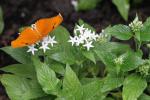
This Julia Butterfly (Dryas iulia) isn't necessarily the flashiest of butterflies. Even with its wings open, it is simply an orange butterfly as you can see to the right. However, when their wings are closed, they're even less spectacular.
But that doesn't make them any less interesting as a photographic subject in my opinion.
Technical Data: Canon EOS 7D, Tamron 180mm f/3.5 Di SP LD 1:1 Macro, 1/260 sec at f/6.4. ISO Auto. Canon Monopod. Phipps Conservatory, Pittsburgh, PA.
Why This Photo: Honestly, I was out specifically to take photos, and specifically out to take photos of butterflies, so...
What Works: Focus is sharp even with only using a monopod with the focus hitting right on the butterfly's eye and mouth.
What Doesn't Work: Framing is just a touch off with the one antenna and the feet of the butterfly break the edge of the shot, and the depth of field could be a bit deeper as the edges of the wings are not as sharp as they could be.
What I'm Not Sure About: I honestly can't decide whether I like the upside-down shot of the butterfly, and can't tell if this shot is interesting or just flat and boring.
Butterfly shots are tricky, but maybe that is why I keep trying them - I like the challenge, and I feel that once I can pull it all together and get that one perfect shot it will be all worth it. Is there a particular shot you keep trying for?
- Bill


